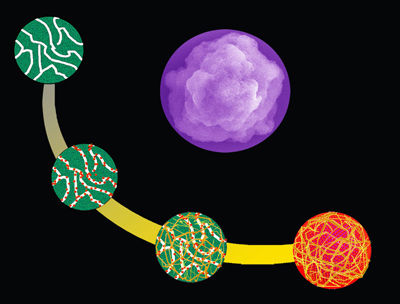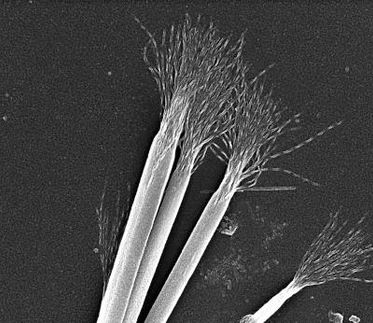Calcium carbonate templates for drug delivery
Microcontainers for medical substances can be produced in different sizes using calcium carbonate microspheres as templates
The fast and targeted delivery of drugs to the focus of a disease could soon be made easier. Helmuth Möhwald and his colleagues from the Max Planck Institute of Colloids and Interfaces in Potsdam-Golm have developed a simple technique for the production of drug containers which can be channelled to a selected target in the body. The researchers use porous calcium carbonate Microspheres as templates for the production of hollow three-dimensional balls. These can absorb medically effective substances and allow signalling molecules to be attached to their surface, with the help of which the spheres can then find their way to the diseased tissue.

Illustration of the production of colloid spheres.
© Dr. X. Yan / MPI of Colloids and Interfaces
Chemotherapy is a successful weapon in the fight against cancer; however, it poses one major problem: the toxic substances not only inhibit the growth of the tumour cells, they also damage healthy tissue. Doctors often face this situation in their use of drugs. Microspheres or nanospheres that deliver drugs to targeted areas of the body and only release them there could help to overcome this problem. The method developed by the researchers at the Max Planck Institute of Colloids and Interfaces makes it possible to produce such spheres in a broad range of sizes and to equip them with different functions.
The researchers start by selecting the calcium carbonate templates in the size that their drug containers should be at the end of the process. These CaCO3 particles can be produced in precisely defined sizes ranging from a few hundred nanometres to several micrometres. The scientists then fill the pores of the calcium carbonate spheres with nanoparticles and, if required, with medical substances. The nanoparticles can thus display different characteristics. They can, for example, consist of a material that is decomposed by light or certain substances and therefore act as openers for the drug vehicle.
The Potsdam-based researchers then surround the filled CaCO3 spheres with a web consisting of long protein chains – alternatively, they can also use polymer threads for this purpose. The next step involves dissolving the CaCO3 template using an acid. The nanoparticles then arrange themselves into a porous sphere that is encased in the protein web. “We can very easily combine substances to form a multifunctional unit and tailor their chemical and physical properties to the required function,” says Möhwald.
The protein web not only covers the hollow sphere, it also makes it biocompatible and can contain biochemical signalling substances that send the spheres directly to their target in the body.
Researchers also use other methods for the production of micro- and nanocontainers that could be suitable for drug delivery. For example, they cause molecules and nanoparticles to cluster together to form such structures using a “bottom-up” approach. “However, our process is easier to control, quicker to implement and more cost-effective than the other techniques developed up to now,” says Helmuth Möhwald.
The Max Planck researcher and his colleagues in Potsdam have achieved an important step in enabling drugs to be delivered in a targeted way to the focus of disease in the body. In Helmuth Möhwald’s view, this fulfils the task of basic research in this area: “Whether or not industry will adopt the method and develop it further to application maturity remains an open question.”
Original publication
Other news from the department science
These products might interest you

NANOPHOX CS by Sympatec
Particle size analysis in the nano range: Analyzing high concentrations with ease
Reliable results without time-consuming sample preparation

Eclipse by Wyatt Technology
FFF-MALS system for separation and characterization of macromolecules and nanoparticles
The latest and most innovative FFF system designed for highest usability, robustness and data quality

DynaPro Plate Reader III by Wyatt Technology
Screening of biopharmaceuticals and proteins with high-throughput dynamic light scattering (DLS)
Efficiently characterize your sample quality and stability from lead discovery to quality control

Get the chemical industry in your inbox
By submitting this form you agree that LUMITOS AG will send you the newsletter(s) selected above by email. Your data will not be passed on to third parties. Your data will be stored and processed in accordance with our data protection regulations. LUMITOS may contact you by email for the purpose of advertising or market and opinion surveys. You can revoke your consent at any time without giving reasons to LUMITOS AG, Ernst-Augustin-Str. 2, 12489 Berlin, Germany or by e-mail at revoke@lumitos.com with effect for the future. In addition, each email contains a link to unsubscribe from the corresponding newsletter.




























































